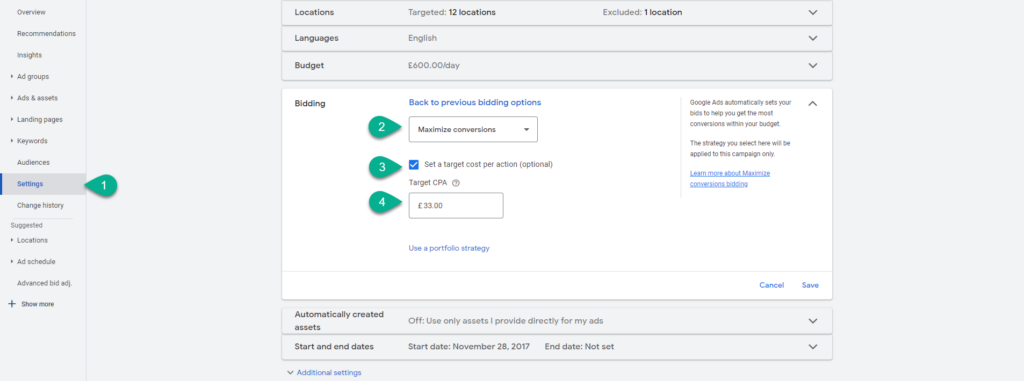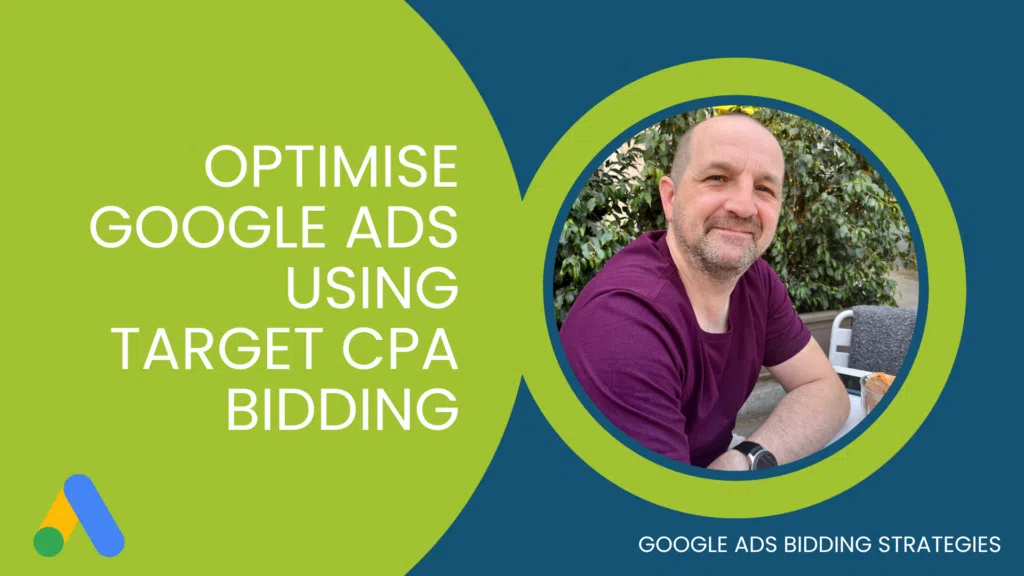Target CPA Bidding in Google Ads: An Explanation
Target CPA (Cost-per-Acquisition) bidding is a Google Ads bidding strategy that lets you set a target CPA for your ad campaigns. The target CPA is the average amount you want to spend for each conversion.
Each time a search occurs in Google, an auction is run in realtime, in which competing advertisers bid to show an ad based on a CPC (cost per click) model. With this bidding strategy, Google Ads automatically sets bids for each auction to try and get as many conversions as possible while staying within your target CPA.
This post is part of the Google Bidding Strategies Guide — created by our Google Ads Agency Team
In this series:
- Manual CPC Bidding in Google Ads: A Comprehensive Guide
- Enhanced CPC (eCPC) Bidding In Google Ads Explained
- How to Optimise Google Ads Using Target CPA Bidding
- How to Optimise Google Ads Using Target ROAS Bidding
- Google Ads Maximise Conversions Bidding Strategy Explained
- Google Ads Maximise Clicks Bidding Strategy Explained
- Google Ads Target Impression Share Bidding Strategy
- How and When to Use the Maximise Conversion Value Bidding Strategy in Google Ads
- Choosing the Best Bidding Strategy for Google Display Ads
- Every YouTube Ads Bidding Strategy Explained
- Bidding Strategies to Maximise Google Shopping Performance
- Manual Bidding vs Automatic Bidding: Which is Better?
Benefits of Target CPA Bidding
One of the main benefits of target CPA bidding is that it can help you achieve your conversion goals while keeping your CPA under control. By setting a target CPA, you can ensure that you’re not overspending on conversions and that you’re getting the best possible value for your ad spend.
Additionally, target CPA bidding can be effective in a variety of different industries and for different types of campaigns. For example, a study by Google found that advertisers who used target CPA bidding saw an average of 21% more conversions at a similar cost per acquisition compared to using manual bidding.
Target CPA Best Practices
Before adopting a Target CPA strategy, there are some best practices you should follow.
Google Ads uses machine learning to inform the bidding for each auction. This is based on historic conversion data from your account and campaigns.
With this in mind, it is important that you have conversion tracking configured correctly and accurately and ideally have recorded at least 30 conversions in the past 30 days. Less conversion data is more likely to create fluctuation in performance and achieved CPA as the machine learns, more data is likely to create more consistent results.
Secondly, you should be prepared for a 2-week learning phase. Depending on your budget, past performance data, this phase can be quite aggressive and it isn’t unusual to see some cases of extremely high CPCs whilst the system tests and learns. Be prepared to stick with it whilst the system learns.
That aggressive learning phase can be shorter, or more lengthy, again depending on the volume of click and conversion data available to the system.
The machine learning never stops, it just continues to learn from ongoing performance data.
You should start with a tCPA bid which is similar to that which your account is achieving until performance is more consistent, then gradually reduce the tCPA in weekly/bi-weekly cycles.
Actions Which Can affect the Machine Learning
You should avoid these actions, where possible.
- Aggressive tCPA bid changes – this can disrupt the machine learning significantly
- Changes to your daily budget – again, significant changes are more likely to cause significant disruption, whereas minor budget changes are more likely to produce more consistent results
- Pausing your campaign – the longer campaigns are paused for, the more disruption is caused
- Changing your conversion actions – this typically produces significant disruption
Actions for Best Results with tCPA bidding
- Keep campaign budgets consistent and continue to feed conversion data to the system
- Continue to optimise campaign performance manually though ad copy optimisation to increase CTR, negative keywords to block search terms which don’t/won’t convert well and structure your ad groups to maximise ad relevance and CTR
- Always, always continue to invest in Conversion Rate Optimisation on your site to improve the conversion rate.
Also see: Conversion Rate Optimisation Services
How to Set Target CPA in Google Ads
To set a target CPA in Google Ads, you can follow these steps:
- In your Google Ads account, navigate to the “Campaigns” tab.
- Select the campaign you want to set a target CPA for.
- Click on “Settings” in the left-hand menu.
- Scroll down to the “Bidding” section and click “Change bid strategy”.
- Select “Target CPA” from the list of available bidding strategies.
- Enter your target CPA in the “Target CPA” field.
- Click “Save” to apply the changes to your campaign.

How to Calculate Target CPA in Google Ads
To calculate your target CPA in Google Ads, you can follow these steps:
- Determine the maximum amount you’re willing to pay for each conversion. This should take into account your profit margins and any other costs associated with acquiring a new customer.
- Analyse historical conversion data in your Google Ads account and calculate your average CPA. This will give you a baseline for setting the target CPA.
- Set your target CPA slightly above or below your historic average CPA, depending on your campaign goals and budget.
Target CPA Formula
Target CPA = (Customer Value x Lead Conversion Rate) x Profit Margin
In this formula, we have a few key elements to consider:
- “Customer Value” reflects the average amount of revenue we expect to generate from each customer.
- “Lead Conversion Rate” represents the percentage of leads that successfully turn into paying customers.
- “Profit Margin” showcases the portion of revenue we keep as profit after deducting our costs.
- By taking these factors into account, we can intelligently evaluate and enhance our advertising strategies, aiming for higher returns and sustainable business growth.
For example, let’s say that your customer value is £1,000, your lead conversion rate is 25%, and your profit margin is 40%. Using the formula above, your target CPA would be:
Target CPA = (£1,000 x 0.25) x 0.4
Target CPA = £100
In this example, your target CPA would be £100 to break even. This means that you’re willing to spend up to £100 for each lead in order to generate a sale that generates £1,000 in revenue, with a 40% profit margin. Based on this, you may want to aim for an actual tCPA of £50 or lower to make a net profit.
Equally, you could improve the performance of your sales process and increase the lead conversion rate from 25% to 33%, which would significantly increase the net profit on the campaign investment.
Avoid lowering your tCPA too much to make it impossible for Google Ads to meet your target. If you do that, bids will lower so much that ads will get very few impressions, in low ad positions and achieve very few clicks and fewer leads.
This is just one way to calculate your target CPA, and there may be other factors to consider depending on your business, your product or service.
Popular Google Ads Videos
CPA vs CPC in Google Ads
CPA (cost-per-acquisition) and CPC (cost-per-click) are both metrics used in Google Ads to measure the effectiveness of your ad campaigns, but they represent different things.
CPC is the cost you pay each time someone clicks on one of your ads. This metric is useful for measuring the cost of generating traffic to your website or landing page for each keyword or search term.
CPA, on the other hand, is the cost you pay for each conversion.
A conversion can be whatever actions you feel are the most valuable to your business – the goals you want to achieve from your campaign. Examples of conversions are, completing your lead form, making a purchase on an eCommerce store, signing up for an email list, registering for an event or calling your phone number.
CPA is useful for measuring the effectiveness of your ad campaigns in terms of generating leads or sales.
How to Calculate the CPA
Average CPC / Conversion Rate = CPA
£0.75 / 2% = £37.50
Target CPA vs Target ROAS
Target CPA and Target ROAS (Return on Ad Spend) are both bidding strategies in Google Ads, but they have different goals.
With Target CPA, the goal is to generate as many conversions as possible while staying within a specific Cost per Acquisition. The focus is on getting the most conversions possible for your budget.
With Target ROAS, the goal is to maximise the revenue generated by your ad campaigns. This bidding strategy focuses on achieving a specific return on investment (ROI) for your ad spend and is most commonly used by eCommerce stores.
Learn more: How to Optimise Google Ads Using Target ROAS Bidding
Recent Google Ads Blog Posts
When You Should Increase Target CPA
There may be times when you need to increase your target CPA to achieve your campaign goals. Here are a few situations where you might consider increasing your target CPA:
- When you’re not generating enough conversions: If you’re not getting enough conversions with your current target CPA, it may be worth increasing your target to see if you can generate more conversions.
- When your CPA is too high: If your CPA is consistently higher than your target, it may be worth increasing your target to see if you can reduce your CPA without sacrificing too many conversions.
- When you’re testing new campaigns: If you’re running a new campaign and you’re not sure what your target CPA should be, it may be worth starting with a higher target CPA and then gradually reducing it as you gather more data.










